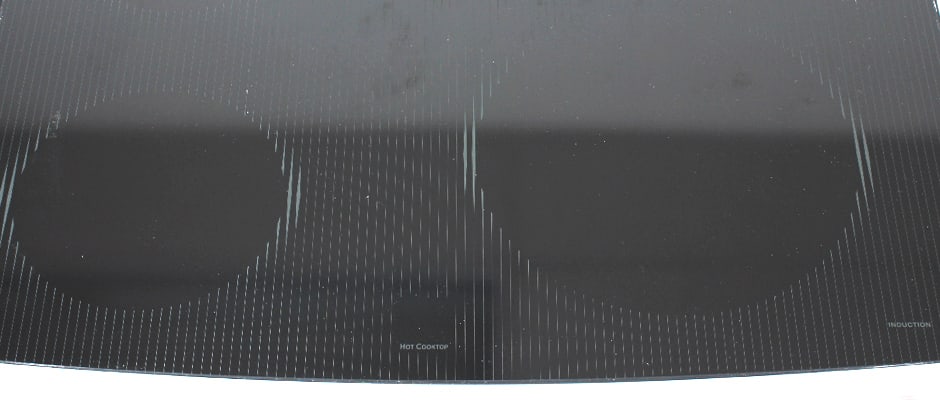Introduction
Design & Usability
{{section_header}}{{section.name}}{{/section_header}}
GE's eye-shaped façade is watching you.
We definitely appreciate GE's unique design language, though it may make it hard to integrate into a kitchen full of appliances from various manufacturers. We're not going to argue whether the oven is good looking—check out the photos and see for yourself—but we do have some criticism for the text-laden control panel, which looks a bit less regal than it should. Nobody wants their range to share buttons with a toy computer from the early '80s.
While oven operation is simple, the induction rangetop has a slight learning curve. Once you put a ferrous (it's ferrous if a magnet sticks to it) pot on the stove, you can turn on the induction coils underneath. Interestingly, you can only use the "Boost" power level on one side of the burner at a time. So if you're using the front right burner on "Boost," the rear right burner is automatically shut off. There are a few other oddities to be aware of, so make sure to consult the use and care guide before you start.
{{photo_gallery "Vanity", "Front", "Rangetop Controls", "Oven Controls", "Burners 1", "Burners 2", "Burners Cleaning", "Upper Oven", "Upper Oven Detail", "Oven Detail", "Lower Oven Detail", "Lower Oven", "Drawer", "Broiler",}}
Rangetop
{{section_header}}{{section.name}}{{/section_header}}
Another impressive induction rangetop.
Just like the rest of the induction ranges we've tested, we've been blown away by this one's impressive boiling, simmering, and searing numbers. With the best burner able to boil six cups of water in two minutes and the worst capable of the same task in five, there is almost no room for improvement. Similarly, the gentle simmering temperatures and hiss-producing searing temperatures make this rangetop as attractive as anything we've seen, especially when you consider that induction rangetops are capable of instant adjustment. The only downside: you may need some new pots and pans that are ferrous. But that's not a bad investment for this kind of performance and speed.
Oven, Broiler, & Convection
{{section_header}}{{section.name}}{{/section_header}}
The excellence we saw up top is nowhere to be found in the oven.
Unfortunately, the oven had trouble hitting a target temperature of 350°F. And when it got there, it had trouble maintaining it — regardless if we set it to normal or convection. Though the range did essentially ace the broiler and maximum temperature tests, the all-important 350°F setting proved to be a disappointment. We expected more from a $3,000 range.
Conclusion
{{section_header}}{{section.name}}{{/section_header}}
If GE could only improve the PHB925STSS's oven issues, it would have a winner. But with a decent selection of induction ranges to choose from on the market, we can't endorse this one. That's partially due to a sub-par oven, and partially due to its $3,000 MSRP. That doesn't take away from its exceptional induction cooktop, but it does prevent us from giving a recommendation.
From Our Lab
{{section_header}}{{section.name}}{{/section_header}}
The {{product.name}} gave a valiant effort, but the oven performance just couldn't match up to high standard set by the impressive rangetop. We're used to see ovens struggling under induction rangetops, but this one struggled a bit more than we could handle, as we recorded some major difficulties with temperature control.
Oven Performance
{{section_header}}{{section.name}}{{/section_header}}
Only the maximum setting is any good.
Let's start with the positive. The maximum setting nailed the target of 550°F (554°F), and maintained that temperature quite well throughout the test. Unfortunately, things get rough as you turn the dial down. Both 350°F settings overheated by at least 23°F, which is terrible. The convection oven operated within an 83°F temperature window (ouch!), which somehow made the conventional oven's 56°F window look good. Bakers beware.
{{photo_gallery "Primary Oven Keep-Warm", "Primary Oven 350F", "Primary Oven Max", "Secondary Oven Convection", "Oven Variance"}}
Rangetop Performance
{{section_header}}{{section.name}}{{/section_header}}
Induction does it again.
Boiling between two and five minutes for every burner? Yup. All burner simmering temperatures under 100°F? Yup. Three out of four burners at the excellent searing temperature of 560°F? Yup. Does it have a lag when you change the temperature? No! Folks, it doesn't get any better than this.
{{photo_gallery "Waterboil", "Simmer"}}
Other Tests
{{section_header}}{{section.name}}{{/section_header}}
The 6-pass broiler may not have the coverage of an 8-pass (fewer bends in the heating element), but this broiler heated up to 600°F in just 5:25, an excellent preheat time.
Meet the tester
Ethan writes reviews and articles about science for Reviewed.com, and edits the Science Blog. He's originally from Vermont and thinks the bicycle and guitar are examples of perfected technology. Prior to Reviewed.com, he studied furiously at Middlebury College.
Checking our work.
Our team is here for one purpose: to help you buy the best stuff and love what you own. Our writers, editors, and lab technicians obsess over the products we cover to make sure you're confident and satisfied. Have a different opinion about something we recommend? Email us and we'll compare notes.
Shoot us an email


